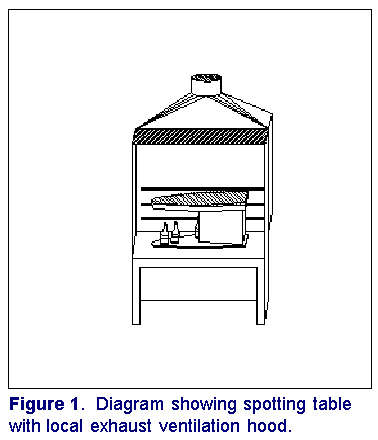Control of Spotting Chemical Hazards In Commercial Drycleaning
1997
DHHS (NIOSH) Publication Number 97-158
Hazard
Many hazardous chemicals are commonly used in drycleaning shops to remove garment stains. Workers performing stain removal may be exposed to these toxic chemicals through skin absorption, eye contact, or inhalation of vapors. The primary hazard is dermatitis from chronic or acute exposure. Dilute hydrofluoric acid, found in some products that remove rust stains, may cause severe chemical burns with deep tissue destruction that may not be evident until several hours after prolonged contact.
Controls
Isolation
- The spotting process should be isolated from other workers. Process isolation is most effective when used in conjunction with good ventilation.
Ventilation
- Local exhaust ventilation (e.g. an exhaust hood) should be used to reduce solvent exposures during the spotting process. An exhaust hood should be located near the source of the spotting chemicals to prevent the vapors from entering the workers’ breathing zone. A slot hood at table level or a downdraft table exhausting to the outside of the building provides good protection for workers. Spotting tables equipped with an exhaust hood are now commercially available (See Figure 1).
- General ventilation should include both supply and exhaust air. Make-up air supply should be designed and used in conjunction with the exhaust system. An inadequate volume of make-up air may result in negative pressure areas, perhaps resulting in drafts that interfere with the exhaust hood. When make-up air is introduced, it should enter the opposite side of the room from the exhaust to prevent short circuiting. Ventilation systems in drycleaning shops should provide a minimum of 30 cfm of outside air per person.

Work Practices
- Spotters should be trained in selective pre-spotting. They should know the proper techniques for stain removal and the correct way to use spotting chemicals in limited quantities. The spotter should recognize stains that will be removed in the drycleaning process and do not require pre-spotting. Spotters who are trained to reduce the number of treated garments will reduce personal exposures.
Personal Protective Equipment
- The spotter should routinely use personal protective equipment (PPE) such as chemical resistant gloves and goggles to reduce dermal exposures. Gloves should be made of solvent-resistant materials, such as Viton® fluoroelastomer, polyvinyl alcohol, or unsupported nitrile. If a solvent permeates a glove material and breaks through to the inside of the glove, the glove can increase chemical exposure by trapping the chemical close to the worker’s skin. Manufacturers of PPE often assist in making the proper choices regarding glove types and life expectancy of the glove material, while considering the specific spotting chemicals being used. Different gloves may be needed for different types of spotting chemicals. Barrier creams may also be used but are less effective than gloves.
- Chemical splash goggles should be worn to prevent eye injury during spotting. Accidental contamination of the eye could result in minor irritation or complete loss of vision. An easily accessible eye wash station should be located near the spotting area. If chemical contamination of the eye occurs, prompt irrigation for at least 15 min can help limit the extent of damage (Figure 2).

A NIOSH technical report, Control of Health and Safety Hazards in Commercial Drycleaners: Chemical Exposures, Fire Hazards, and Ergonomic Risk Factors, has been published on this subject. This document is one in a series of seven HAZARD CONTROLS concerning control of hazards in the drycleaning industry that are available free upon request.
*NIOSH is the Federal agency responsible for conducting research and making recommendations for preventing work-related illnesses and injuries. All HAZARD CONTROLS are based on research studies that show how worker exposures to hazardous agents or activities can be significantly reduced.
The principal contributors to this publication are Gary S. Earnest, Lynda Ewers, Avima Ruder, Linda Goldenhar, Daniel S. Watkins, Rosmarie T. Hagedorn, and Jerome P. Flesch.
This document is in the public domain and may be freely copied or reprinted. NIOSH encourages all readers of this HAZARD CONTROLS to make it available to all interested employers and workers.
Control of Spotting Chemical Hazards In Commercial Drycleaning [PDF – 67 KB]
